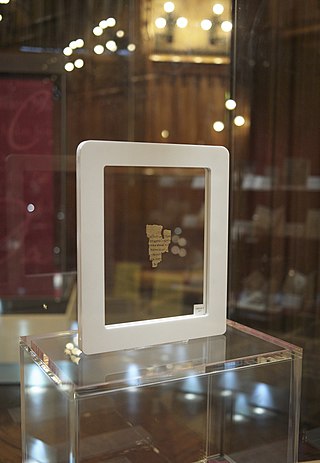Related Research Articles

Papyrus is a material similar to thick paper that was used in ancient times as a writing surface. It was made from the pith of the papyrus plant, Cyperus papyrus, a wetland sedge. Papyrus can also refer to a document written on sheets of such material, joined side by side and rolled up into a scroll, an early form of a book.

Papyrology is the study of manuscripts of ancient literature, correspondence, legal archives, etc., preserved on portable media from antiquity, the most common form of which is papyrus, the principal writing material in the ancient civilizations of Egypt, Greece, and Rome. Papyrology includes both the translation and interpretation of ancient documents in a variety of languages as well as the care and conservation of rare papyrus originals.
Posidippus of Pella was an Ancient Greek epigrammatic poet.
The Milan Papyrus is a papyrus roll inscribed in Alexandria in the late 3rd or early 2nd century BC during the rule of the Ptolemaic dynasty.

The Rylands Library Papyrus P52, also known as the St John's fragment and with an accession reference of Papyrus Rylands Greek 457, is a fragment from a papyrus codex, measuring only 3.5 by 2.5 inches at its widest, and conserved with the Rylands Papyri at the John Rylands University Library Manchester, UK. The front (recto) contains parts of seven lines from the Gospel of John 18:31–33, in Greek, and the back (verso) contains parts of seven lines from verses 37–38. Since 2007, the papyrus has been on permanent display in the library's Deansgate building.

The Derveni papyrus is an ancient Greek papyrus roll that was found in 1962. It is a philosophical treatise that is an allegorical commentary on an Orphic poem, a theogony concerning the birth of the gods, produced in the circle of the philosopher Anaxagoras. The roll dates to around 340 BC, during the reign of Philip II of Macedon, making it Europe's oldest surviving manuscript. The poem itself was composed near the end of the 5th century BC, and "in the fields of Greek religion, the sophistic movement, early philosophy, and the origins of literary criticism it is unquestionably the most important textual discovery of the 20th century." While interim editions and translations were published over the subsequent years, the manuscript as a whole was finally published in 2006.

Artemidorus of Ephesus was a Greek geographer, who flourished around 100 BC. His work in eleven books is often quoted by Strabo. What is thought to be a possible fragment of his work is considered by some scholars to be a forgery.
Papyrus 93, designated by 𝔓93, is a copy of the New Testament in Greek. It is a papyrus manuscript of the Gospel of John. The surviving texts of John are verses 13:15-17. The manuscript paleographically has been assigned to the middle 5th century.
Uncial 0174, is a Greek uncial manuscript of the New Testament, dated paleographically to the 5th century.
Papyrus 126, designated by siglum 𝔓126, is a copy of the New Testament in Greek. It is a papyrus manuscript of the Epistle to the Hebrews.
Marcus Petronius Mamertinus, possibly known as Sextus Petronius Mamertinus, was a Roman senator originally of the Equestrian order. He served as suffect consul in 150 AD as the colleague of Marcus Cassius Apollinaris.
Flavius Dioscorus lived during the 6th century AD in the village of Aphrodito, Egypt, and therefore is called by modern scholars Dioscorus of Aphrodito. Although he was an Egyptian, he composed poetry in Greek, the cultural language of the Byzantine Era. The manuscripts, which contain his corrections and revisions, were discovered on papyrus in 1905, and are now held in museums and libraries around the world. Dioscorus was also occupied in legal work, and legal documents and drafts involving him, his family, Aphroditans, and others were discovered along with his poetry. As an administrator of the village of Aphrodito, he composed petitions on behalf of its citizens, which are unique for their poetic and religious qualities. Dioscorus was a Christian and lived in a religiously active environment. The collection of Greek and Coptic papyri associated with Dioscorus and Aphrodito is one of the most important finds in the history of papyrology and has shed considerable light on the law and society of Byzantine Egypt. The papyri are also considered significant because of their mention of Coptic workers and artists dispatched to the Levant and Arabia to work on early Umayyad architectural projects.

Guglielmo Cavallo is an Italian palaeographer, Emeritus Professor of the Sapienza University of Rome.
Edgar Lobel was a Romanian-British classicist and papyrologist who is best known for his four decades overseeing the publication of the literary texts among the Oxyrhynchus Papyri and for his edition of Sappho and Alcaeus in collaboration with Denys Page. His contributions to the fields of papyrology and Greek studies were many and substantial, and Eric Gardner Turner believed that Lobel should "be acknowledged as a scholar to be mentioned in the same breath as Porson and Bentley, a towering genius of English scholarship."
Angelo Torricelli is an Italian architect.
Peter John Parsons, was a British classicist and academic specialising in papyrology. He was Regius Professor of Greek at the University of Oxford from 1989 to 2003.

Medea Vittoria Irma Norsa (1877–1952) was an Italian papyrologist and philologist. She headed the Istituto Papirologico Girolamo Vitelli in Florence from 1935 to 1949.

The Ptolemaic cult of Alexander the Great was an imperial cult in ancient Egypt during the Hellenistic period, promoted by the Ptolemaic dynasty. The core of the cult was the worship of the deified conqueror-king Alexander the Great, which eventually formed the basis for the ruler cult of the Ptolemies themselves. The head priest of the imperial cult was the chief priest in the Ptolemaic Kingdom.

A New Testament amulet is an ancient hand-written portion of the New Testament, commonly worn as a charm. The Lord's Prayer is the most common text found on amulets. Also commonly found are the opening verses of each of the four New Testament gospels.
Gaius Galerius was a Roman eques who was active during the reign of Tiberius. He is best known as the praefectus or governor of Egypt (16-32).
References
- ↑ Guido Bastianini - Curriculum Vitae Il Portale Italiano di Archeologica